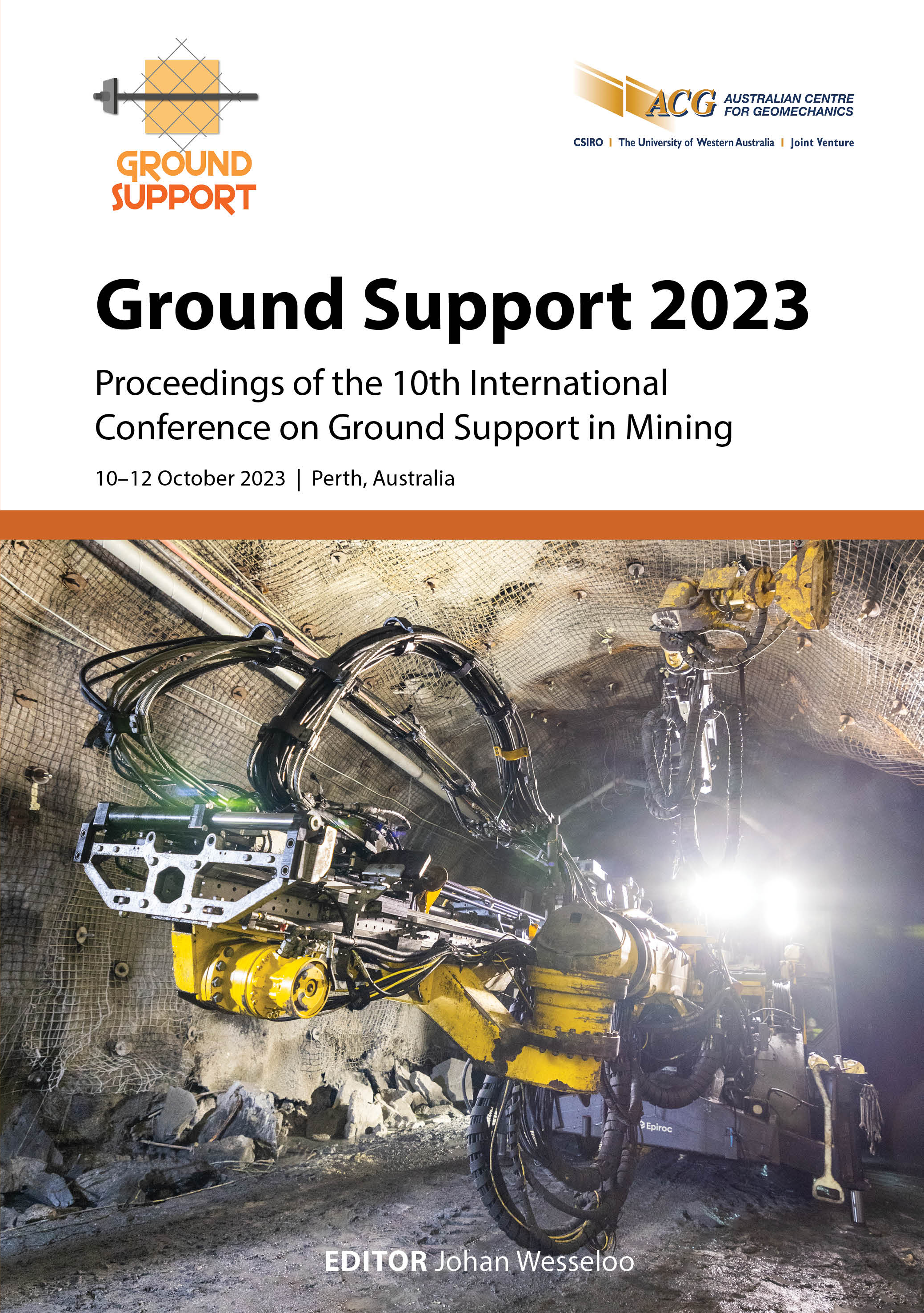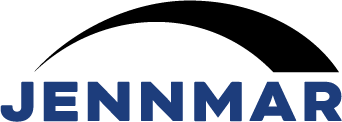Mine portal design: considerations, methods and practices

|
Authors: Dunn, MJ; Parrott, TT |
DOI https://doi.org/10.36487/ACG_repo/2325_16
Cite As:
Dunn, MJ & Parrott, TT 2023, 'Mine portal design: considerations, methods and practices', in J Wesseloo (ed.), Ground Support 2023: Proceedings of the 10th International Conference on Ground Support in Mining, Australian Centre for Geomechanics, Perth, pp. 237-254, https://doi.org/10.36487/ACG_repo/2325_16
Abstract:
Mine access portals are routinely developed to provide access to underground mines; typically, they are either developed within an existing open pit or in a specially developed box cut. Portals are critical mine access excavations requiring rigorous design and construction practices. In some cases, the portal will serve as a single means of access and egress for a significant period and this requires that design acceptance criteria be commensurate with the acceptable risk being adopted. Failure of a portal can result in both safety and economic consequences. In the authors’ view, the rigour around design effort, acceptance criteria and construction quality control are not always at the required level. Mine access portals can be developed in a range of rock mass conditions including soils, weak weathered rocks such saprolites, to competent good quality rock masses. Portal design requires an understanding and consideration of the geotechnical conditions, likely failure mechanisms, hazards and risk, as well as the intended period that it will serve as the main access to the mine. A range of design methods (empirical, analytical, numerical etc.) can then be used to assess likely loading conditions and the required ground support. Portal designs also need to consider the stability of the slope into which it is developed; in a box cut it is possible to engineer a stable slope whilst in an open pit it is necessary to deal with an already cut slope. This paper discusses typical hazards and risk associated with mine access portals as well as a range of design methods. A framework for portal design is presented including construction aspects and monitoring. Examples for several portals developed in a range of different rock mass conditions using different design methods and support methods are presented.
Keywords: portal design, design effort, design acceptance criteria
References:
Andrieux, P & Brummer, R 2005, ‘Theoretical and practical considerations on the performance of various shotcrete applications for ground support in mines’, Proceedings of the 20th Colloquium on Ground Control of the Quebec Mining Association.
Barton, N, Lien, R & Lunde, J 1974, ‘Engineering classification of rock masses for the design of rock support’, Rock Mechanics, vol. 6, pp. 189–236.
Beer, G & Meek, JJ 1982, ‘Design curves for roofs and hangingwalls in bedded rocks based on ‘voussior’ beam and plate solutions’, Transactions of the Institute of Mining and Metallurgy, vol. 91, pp. A18–A22.
Bentley 2023, Microstran, computer software, Bentley, Exton.
Bieniawski, ZT 1976, ‘Rock mass classification in rock engineering’, in ZT Bieniawski (ed.), Exploration for Rock Engineering: Proceedings of the Symposium on Exploration for Rock Engineering, A.A. Balkema, Lisse, pp. 97–106.
Bieniawski, ZT 1989, Engineering Rock Mass Classifications, John Wiley & Sons, New York.
Bieniawski, ZT, 1992, ‘Principles of engineering design for rock mechanics’, in JR Tillerson & WR Wawersik (eds), Proceedings of the 33rd US Symposium on Rock Mechanics, A.A. Balkema, Rotterdam, pp. 1031–1040.
Dassault Systèmes 2023, Abaqus, computer software, Dassault Systèmes, Paris.
Dunn, MJ 2013, ‘Uncertainty in ground support design and implementation in underground mining’, in Y Potvin & B Brady (eds), Ground Support 2013: Proceedings of the Seventh International Symposium on Ground Support in Mining and Underground Construction, Australian Centre for Geomechanics, Perth, pp. 345–358,
Dunn, MJ 2015, ‘How reliable are your design inputs?’, in Y Potvin (ed.), Design Methods 2015: Proceedings of the International Seminar on Design Methods in Underground Mining, Australian Centre for Geomechanics, Perth, pp. 367–381,
Dunn, MJ 2019, ‘Quantifying uncertainty in mining geomechanics design’, in J Wesseloo (ed.), MGR 2019: Proceedings of the First International Conference on Mining Geomechanical Risk, Australian Centre for Geomechanics, Perth, pp. 391–402,
Graaf, JH & Parrott, T 2013, ‘Guidelines for the design and construction of underground portals in open pits – a case study of the Gateway Mine’, in Y Potvin & B Brady (eds), Ground Support 2013: Proceedings of the Seventh International Symposium on Ground Support in Mining and Underground Construction, Australian Centre for Geomechanics, Perth, pp. 421–436,
Goodman, RE & Shi, G 1985, Block Theory and its Application in Rock Engineering, Prentice Hall, Upper Saddle River.
Hadjigeorgiou, J 2012, ‘Where do the data come from?’, in Y Potvin (ed.), Deep Mining 2012: Proceedings of the Sixth International Seminar on Deep and High Stress Mining, Australian Centre for Geomechanics, Perth, pp. 259–277,
/ACG_rep/1201_19_hadjigeorgiou
Hadjigeorgiou, J & Harrison, JP 2011, ‘Uncertainty and sources of error in rock engineering’, in Q Qian & X Zhou (eds), Proceedings of the 12th ISRM International Congress on Rock Mechanics, Harmonising Rock Engineering and the Environment, CRC Press, Leiden, pp. 2063–2067.
Hoek, E 1991, ‘When is a design in rock engineering acceptable?’, Müller Lecture, Proceedings of the 7th International Congress on Rock Mechanics, A.A. Balkema, Rotterdam, vol. 3, pp 1485–1497.
Hoek, E, Kaiser, PK & Bawden, WF 1995, Support of Underground Excavations in Hard Rock, A.A. Balkema, Rotterdam, 300 p.
Fillion, M-H & Hadjigeorgiou, J 2013, ‘Reliability of strength estimates based on limited laboratory data’, in PM Dight (ed.), Slope Stability 2013: Proceedings of the 2013 International Symposium on Slope Stability in Open Pit Mining and Civil Engineering, Australian Centre for Geomechanics, Perth, pp. 163–176,
Itasca Consulting Group, Inc 2023, FLAC3D, computer software, Itasca Consulting Group, Inc, Minneapolis.
Lambe, TW 1985, ‘Amuay landslides’, Proceedings of the 11th International Conference on Soil Mechanics and Foundation Engineering, Golden Jubliee Volume, A.A. Balkema, Rotterdam, pp. 137–158.
Norwegian Geotechnical I 2015, Using the Q-System – Rock Mass Classification and Support Design, Oslo.
Potvin, Y & Hadjigeorgiou, J 2015, ‘Empirical ground support design of mine drives’, in Y Potvin (ed.), Design Methods 2015: Proceedings of the International Seminar on Design Methods in Underground Mining, Australian Centre for Geomechanics, Perth, pp. 419-430,
Rocscience Inc 2023a, Unwedge, computer software, Rocscience Inc, Toronto.
Rocscience Inc 2023b, RS2, computer software, Rocscience Inc, Toronto.
Rocscience Inc 2023c, RS3, computer software, Rocscience Inc, Toronto.
Rocscience Inc 2023d, Slide2, computer software, Rocscience Inc, Toronto.
Rocscience Inc 2023e, Swedge, computer software, Rocscience Inc, Toronto.
Rocscience Inc 2023f, Dips, computer software, Rocscience Inc, Toronto.
Rogers, GK & Haycocks, C 1988, ‘Portal stability in rock’, Proceedings of the Seventh International Conference on Ground Control in Mining, pp. 76–83.
Rogers, GK & Haycocks, C 1989, ‘Rock classification for portal design’, Rock Mechanics as a Guide for Efficient Utilization of Natural Resources, A.A. Balkema, Rotterdam, pp. 23–30.
Silva, FM, Lambe, TW & Marr, WE, 2008, ‘Probability and risk of slope failure’, Journal of Geotechnical and Geoenvironmental Engineering, vol. 134, no. 12.
Singh, B, Jethwa, JL & Dube, AK 1995, ‘A classification system for support pressure in tunnels and caverns’, Journal of Rock Mechanics and Tunnelling Technology, vol. 1, no. 1, pp. 13–24.
Stacey, TR 2004, ‘The link between the design process in rock engineering and the code of practice to combat rock fall and rockburst accidents’, The Journal of The South African Institute of Mining and Metallurgy, January/February, pp. 29–34.
Stacey, TR 2008, ‘Are design codes appropriate in mining rock engineering?’, in Y Potvin, J Carter, A Dyskin & R Jeffrey (eds), SHIRMS 2008: Proceedings of the First Southern Hemisphere International Rock Mechanics Symposium, Australian Centre for Geomechanics, Perth, pp. 129–136,
Stacey, TR 2009, ‘Design—a strategic issue’, Journal of The Southern African Institute of Mining and Metallurgy, vol. 109,
pp. 157–162.
Stephenson, RM & Sandy, MP 2021, ‘Considerations for the design and support of underground portals’, Proceedings of the Underground Operators Conference 2021, Australasian Institute of Mining and Metallurgy, Melbourne, pp. 374–388.
Terzaghi, K 1946, ‘Introduction to tunnel geology’, in RV Proctor & TL White TL (eds), Rock Tunnelling With Steel Supports, Commercial Shearing and Stamping Company, Youngstown.
US Army Engineer Waterways Experiment Station 1960, The Unified Soil Classification System, technical memorandum no. 3-357, Vicksburg.
© Copyright 2025, Australian Centre for Geomechanics (ACG), The University of Western Australia. All rights reserved.
View copyright/legal information
Please direct any queries or error reports to repository-acg@uwa.edu.au
View copyright/legal information
Please direct any queries or error reports to repository-acg@uwa.edu.au
